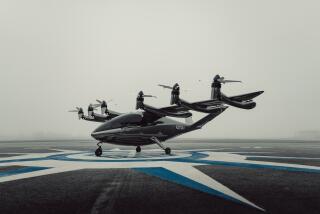U.S. Study Backs Tilt-Rotor Craft to Ease Air Traffic : Travel: By the year 2000, millions of passengers would be served by ‘vertiports’ in major cities. Opponents say it will be costly.
- Share via
WASHINGTON — Although it would cost at least $2 billion, development of a tilt-rotor aircraft that could significantly relieve air traffic congestion by the turn of the century is technically and economically feasible, according to a federal study released Wednesday.
The study, sponsored by the Federal Aviation Administration and the National Aeronautics and Space Administration, says commercial tilt-rotor planes could serve as many as 12 million passengers at specially designed urban “vertiports” on the East Coast by 2000.
A tilt-rotor plane is a hybrid aircraft that--like a helicopter--can take off and land vertically from a small pad within a city. But it also can rotate its engines to fly horizontally at high speeds like an airplane.
Supporters contend that tilt-rotor aircraft could cut air traffic in crowded transportation corridors by replacing high-demand, short-haul commercial flights between such cities as Los Angeles and San Francisco or Washington and New York City.
A prototype military tilt-rotor plane known as the V-22 Osprey has been successfully test-flown, but a Pentagon program to begin large-scale production was killed in 1989 by Defense Secretary Dick Cheney.
“There is a large potential demand for its civilian use, especially in high-density air markets in this country, Europe and Japan,” said Rep. Jim Oberstar (D-Minn.), chairman of the House subcommittee on aviation.
The study said the 39-seat Osprey, built jointly by Bell Helicopter Textron and Boeing Helicopters, was the most likely possibility for commercial development. The two firms and the Boeing Commercial Airplane Group assisted in preparing the tilt-rotor study.
A tilt-rotor system with 12 vertiports serving the Boston-New York-Philadelphia-Washington corridor could divert as much as 15% of current total passenger traffic away from airports, the study said. The expense would be only about half of the estimated $4 billion to $6 billion cost of a single new airport, it said.
The study projects that 2,600 commercial tilt-rotor aircraft could be in operation worldwide by the year 2000. About 1,300 tilt-rotors would be operating in the United States, where they would carry 40,000 passengers on 1,000 flights a day.
Critics, however, contend a tilt-rotor system would be too expensive to operate commercially. A study carried out by Avmark, an aviation consulting firm, in the late 1980s estimated that a ticket would cost three times as much as a regular commercial air fare. In addition, increasing public concern about air traffic noise could lead to local opposition.
The new study rejected plans for tilt-rotor transportation involving smaller cities, saying they would not generate enough traffic to make the system economically viable.
It said the next step should be the formation of a partnership of federal and state governments and private firms to decide by 1995 whether a tilt-rotor system is economically attractive and in the national interest.
More to Read
Inside the business of entertainment
The Wide Shot brings you news, analysis and insights on everything from streaming wars to production — and what it all means for the future.
You may occasionally receive promotional content from the Los Angeles Times.










